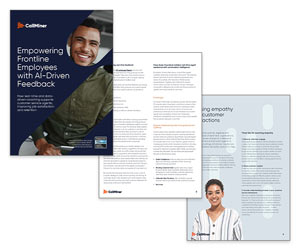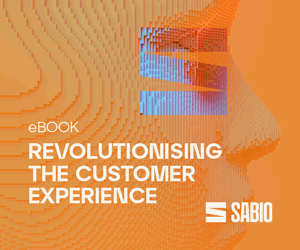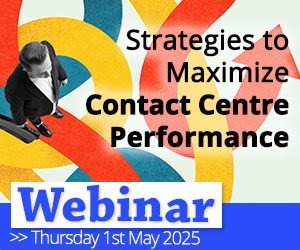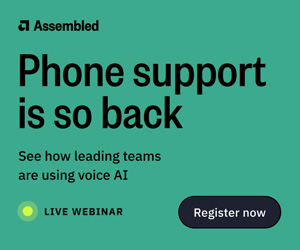CallMiner explores what employee experience is, why it matters, what an effective employee experience strategy needs, and how to optimize your strategy.
Employees are often expected to wear multiple hats daily while prioritizing the customer experience. But what happens if the employee experience isn’t as important to a company?
Without an effective employee experience strategy, employees may experience burnout, a loss of productivity, and overall reduced morale.
What Is Employee Experience?
Employee experience is the overall experience an employee has with the company they work for. It includes things like the hiring process, interactions with managers, and daily responsibilities. Employee engagement, retention, and productivity are all parts of the employee experience.
Why Employee Experience Matters
Employee experience is directly correlated with employee engagement. Engaged employees are more likely to be committed to their work, leading to higher levels of performance and reduced turnover rates.
According to a Gallup survey, only one-third of US employees were actively engaged in their workplace in 2023. Also per Gallup, “Not engaged or actively disengaged employees account for approximately $1.9 trillion in lost productivity nationally.”
When organizations invest in creating a positive employee experience, they foster a sense of belonging and purpose among their workforce. This can result in improved morale and collaboration, ultimately translating into better business outcomes.
An effective employee experience strategy can also enhance a company’s reputation as an employer of choice. Organizations that cultivate a positive work environment and prioritize employee well-being stand out in the talent market, which can attract top performers.
What Does an Effective Employee Experience Strategy Need?
An effective employee experience strategy should create a motivating, supportive, and productive environment for employees.
The following components work together to ensure that employees feel valued and equipped to perform at their maximum potential.
Leadership Culture and Support
Leadership buy-in is essential for fostering a positive employee experience and supportive work environment.
Leaders set the tone for the workplace by encouraging communication and collaboration, a safe place to share ideas and feedback, and providing opportunities for professional development.
Ongoing Training and Development Opportunities
Employees want to feel like their employer prioritizes their development and training. Companies should invest in training tools and resources when new practices or tools are implemented and continuously to foster ongoing skill development.
Technology and Tools
The right technology can streamline workflows and reduce employee stress. These tools should aid employees rather than overwhelm them, such as real-time guidance, communication platforms, and AI-powered knowledge bases.
Recognition and Rewards
Regular recognition and reward programs can boost employee satisfaction by making them feel appreciated for their efforts and successes and giving them something to work toward.
Celebrating successes also incentivizes and reinforces positive behaviours that can have a powerful impact on the workplace.
Optimizing Your Employee Experience Strategy
Keep your employee experience strategy effective and relevant over time by adopting these practices.
Set Success Goals
Setting clear success goals allows you to define what success means to you in terms of employee experience and provide measurable outcomes to track progress.
Focus on key metrics like employee engagement, retention rates, and productivity levels, which you can measure using employee experience software. Regularly review your success goals to make sure your strategy remains focused on the current needs of your team.
Assess the Employee Experience
With clear goals established, you can now evaluate the employee experience based on those goals. Gather feedback continuously through employee satisfaction surveys, one-on-one meetings, and data analytics tools to identify pain points and opportunities for improvement.
Your assessment should consider both the personal and professional aspects of your employees’ daily work lives.
Incorporate Employee Feedback
Actively listening to your team’s feedback and suggestions shows that you value their voices and opinions, which can encourage a culture of trust and healthy communication.
Use the feedback you’ve gathered to take action on improving the employee experience based on common threads found in the feedback.
Communicate any changes clearly and immediately to employees so they see that their feedback makes a difference.
Implement Real-Time Support
Adding real-time support to employees can help them feel more prepared for any situation they need to handle, whether it’s a comprehensive AI-powered knowledge base or real-time coaching during customer phone calls and interactions.
By reducing uncertainty and boosting decision-making skills, real-time support can alleviate stress, increase productivity and efficiency, and enhance overall job satisfaction.
Encourage Communication and Collaboration
Employees who feel comfortable communicating their thoughts and collaborating with others might be your happiest employees.
According to Statista research from 2019, 60% of employees consider their colleagues important to their overall job satisfaction.
Companies should prioritize healthy socialization, trust-building exercises, and open-door policies to build trust and honesty among employees.
Measure the Impact of Your Employee Experience Strategy
An employee experience strategy needs regular evaluation to ensure its success over time. Employee experience software can help streamline the process.
Conversation intelligence solutions can track key metrics like productivity, employee performance, and engagement to determine where improvement can occur and adjust your strategy as needed.
Frequently Asked Questions
What Is the Role of Technology in Enhancing Employee Experience in a Contact Centre?
Technology plays a key role in contact centre employee experience strategies. Contact centre software helps employees streamline workflows, receive real-time support, and reduce task-related friction.
How Often Should a Company Revisit and Update Its Employee Experience Strategy?
Companies should typically revisit and update their employee experience strategies at least once per year, although large organizations with numerous employees may want to re-evaluate their strategies every six months.
This frequency can help a company stay aligned with the priorities of its employees, which can evolve with time.
What Is the Most Important Element of a Strong Employee Experience Strategy?
Effective communication is generally the most important element of an employee experience strategy.
Employees should feel comfortable communicating their thoughts with management and peers, and management should welcome open and transparent communication from employees. This fosters a safe and nurturing environment for all employees.
This blog post has been re-published by kind permission of CallMiner – View the Original Article
For more information about CallMiner - visit the CallMiner Website
Call Centre Helper is not responsible for the content of these guest blog posts. The opinions expressed in this article are those of the author, and do not necessarily reflect those of Call Centre Helper.
Author: CallMiner
Reviewed by: Megan Jones
Published On: 3rd Feb 2025
Read more about - Guest Blogs, CallMiner






 CallMiner is the leading cloud-based customer interaction analytics solution for extracting business intelligence and improving agent performance across all contact channels.
CallMiner is the leading cloud-based customer interaction analytics solution for extracting business intelligence and improving agent performance across all contact channels. 
































